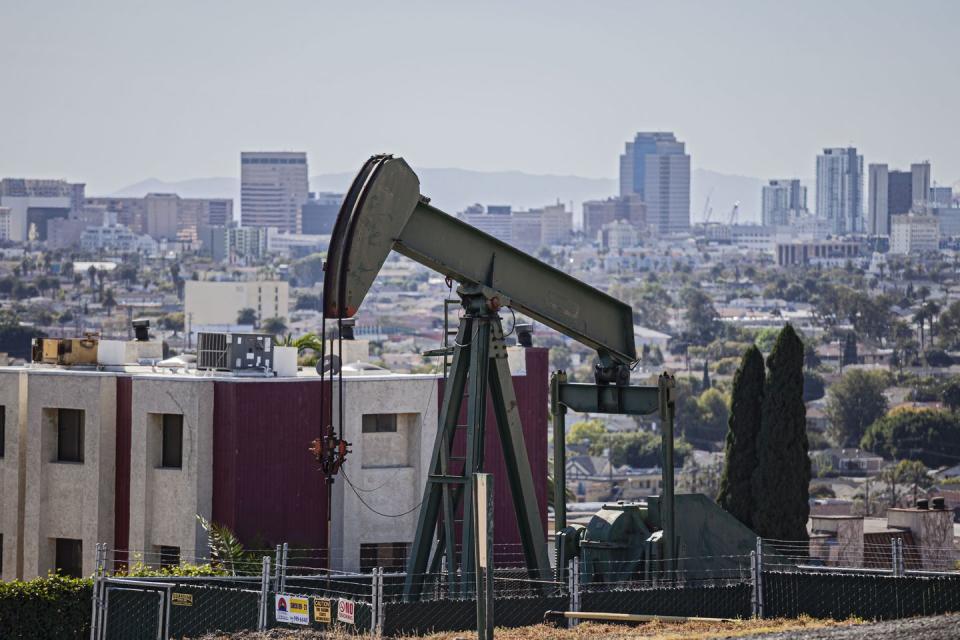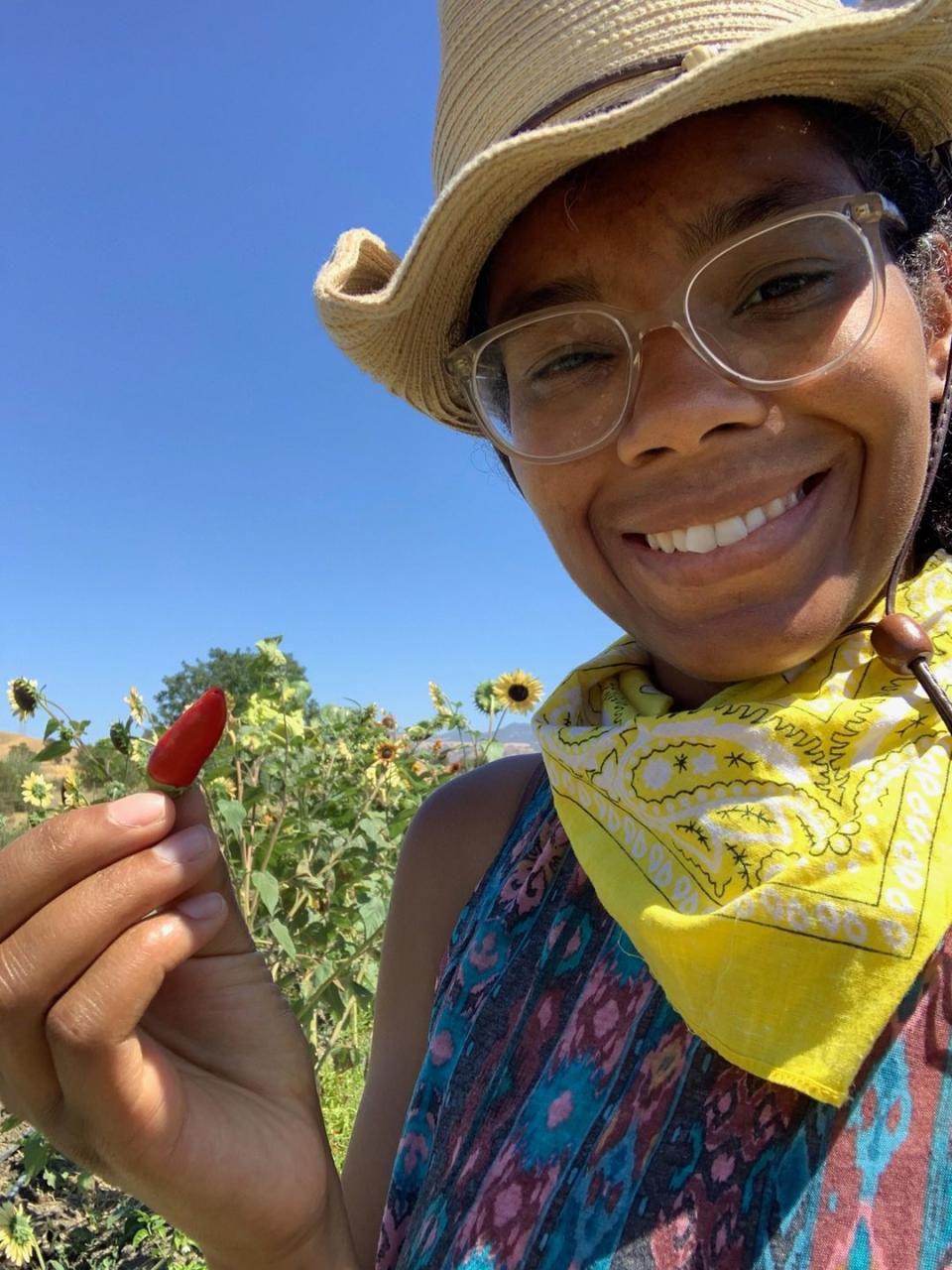‘For Us, Environment Is Everything’: Why Abolishing Racism Must Include Protecting The Planet

"Hearst Magazines and Yahoo may earn commission or revenue on some items through the links below."

When Deseree Fontenot was diagnosed with asthma, she never considered what caused it. As a teenager, the struggle to breathe prevented her from participating in any recreational activities where she would get winded easily. Her mom was affected by the condition as well. It wasn’t until much later in life, when Fontenot was in college, that she drew a connection between the pulmonary condition that inflamed and narrowed her and her mother’s airways and where they lived in Los Angeles.

Oil production in L.A. began in the late 1800s, and by 1930, California was producing about one quarter of the world’s oil output. Today, it is the seventh-largest oil-producing state in the U.S., and if it were a country, it would be the forty-first biggest oil producer in the world. L.A. still contains thousands of oil wells, many of which are active and disproportionately located in low-income neighborhoods where communities of color reside. Proximity to these oil wells has been linked to asthma, cancer, cardiovascular diseases, preterm birth, and other long-term health effects, according to a study in the journal Science of the Total Environment.
“The reason we have asthma…[is because] where we were able to make a home was in the sprawl of urban development of Los Angeles,” says Fontenot. “That’s part of my lived experience; it’s not just this abstract thing.”

The issues that Fontenot faced growing up stem from a disparity that commonly impacts people of color, known as environmental racism. Globally, environmental racism can be defined as the process of ecosystem destruction and climate degradation that is produced largely by Western and/or industrialized countries, with countries in the Global South largely bearing the burden of the consequences. In the U.S. specifically, environmental racism refers to how legal, social, political, and cultural entities intersect with state-sanctioned environmental agendas to create outcomes that adversely affect communities of color.
“The impacts of environmental degradation are unequally experienced because this group lives next to an oil refinery, this group lives next to a nuclear waste dump…this is just a continuous cycle,” says Fontenot.
Fontenot, who is now a co-director of Oakland, California’s Movement Generation Justice & Ecology Project, an organization that provides education, trainings, and workshops on the intersection of climate activism and racism, emphasizes that anti-racist work that includes an environmental lens is crucial.
But traditional environmental movements have often neglected the issues faced by communities of color, focusing their campaigns on the preservation of often far-away animal and plant species over the acknowledgment that many humans live in polluted places because of systemic racism, right here at home, and that change is needed to save the health of these communities.
“The issue with the environmental movement for so many years has been a lack of diversity and a lack of shared lenses around environmental racism,” Fontenot says. “We don’t see ourselves in that movement, but we do see ourselves in the places which we’ve had to make home over and over again, places that are deeply affected by processes like extraction, or the forceful removal of natural resources from their rightful place at a scale, pace, and intensity that ecosystems cannot recover from or regenerate.”
That’s why Fontenot started working with Movement Generation. She didn’t see Black people like herself in the environmental space. She’s working to change both what the environmental movement looks like, and what they’re fighting for: environmental justice.

The History of Environmental Racism Is Centuries-Long
While the term environmental racism was technically coined by the Black civil rights leader Benjamin Chavis in 1987, in the United States, environmental justice workers and advocates like Fontenot take a long view of the process, finding its genesis in the settler colonization and slavery of the country.

“It really starts in…colonialization, in the extraction of our land and our labor,” says Elizabeth Yeampierre, executive director of the Brooklyn-based UPROSE, an organization that focuses on sustainable development and a myriad of community issues, including climate and racial justice. “It starts with us having access to the worst food, being put in places where all of a sudden, we’re surrounded by petrochemical industries, having the worst water, the worst health care…for us, environment is everything.”

Yeampierre, a Puerto Rican woman of African and Indigenous ancestry, was born in New York City, and raised in many different city neighborhoods due to continuous displacement. The environmental impact of the colonial and enslavement history of the U.S., combined with the psychological stress of structural racism, has created conditions that make “manifesting as healthy people” difficult to achieve for many people of color, Yeampierre says.
And this isn’t an issue of income level. Race “continues to be an independent predictor of where hazardous wastes are located, and it is a stronger predictor than income, education, and other socioeconomic indicators,” per a study that evaluated toxic waste from 1987 to 2007. The same research also found that Black children were five times more likely to have lead poisoning from proximity to waste than white children. What’s more, Black Americans making $50,000 to $60,000 a year were more likely to live in polluted areas than their white counterparts making $10,000, according to a study from Sociological Perspectives.
“People like to redefine environmental racism for us, and they like to say that this is an issue of people from low incomes. But if you’re Black and middle income, chances are you still live in extreme environments and burdens,” Yeampierre says.

Segregation and redlining are major contributors to environmental racism as well, says Leah Thomas, activist and author of The Intersectional Environmentalist: How to Dismantle Systems of Oppression to Protect People + Planet.
Redlining is the systemic practice of denying loans, restricting insurance benefits, and enacting unfair and abusive terms on borrowers, historically levied on communities of color, the result of which is the discrimination people of color have historically faced in acquiring property. This began after the Great Depression in the 1930s, when President Franklin Delano Roosevelt implemented the New Deal in the name of economic relief and offered incentives for people to move out of inner city neighborhoods and into the suburbs. But racist banking practices and discriminatory mortgage programs made it much harder for Black folks to take advantage of those incentives and get housing loans, meaning they were left in neighborhoods that were underdeveloped, polluted, and had lower property values (leaving them unable to accrue wealth through home ownership in the way white families could). The Home Owners’ Loan Cooperation then made maps that graded neighborhoods, ranking as lowest and outlining in red the areas where communities of color lived, making it even harder for people who lived there to get access to loans to move out. These maps are where the term redlining comes from.

“It wasn’t separate-but-equal as we know. So, in the U.S. specifically, we started to see a lot of Black and Brown communities be closer to toxic landfills and waste sites and more highways in their neighborhoods,” Thomas says. “The design of cities also has a lot to do with environmental racism.”
You can see the effects of these racist policies in a quick scan of the major environmental catastrophes that have made headlines in the country over the past few years, like the Flint water crisis, toxic waste in the Rio Grande Valley, and the construction of the Dakota Access Pipeline, which threatens to pollute the drinking water source of the Standing Rock Sioux. Yeampierre also points out the devastation to Puerto Rico caused by Hurricane Maria in 2017, which led to poor air and water quality.

Citing her own multigenerational family history, Yeampierre recounts how her grandmother was forced to move from an agricultural part of Puerto Rico to El Fanguito, one of the worst slums in San José, because of the rise of extractive industries. Poor nutrition and disease in the slum led to the deaths of seven of her grandmother’s children, and the environmental degradation that accompanied the extractive industries in the area (as well as in New York) has led to generations of her family being plagued by respiratory illness. The environment in Puerto Rico has only worsened since that time, with climate change and disasters like the hurricane.
“There’s this land that’s highly toxic and contaminated that was hit by this hurricane, and the chemicals and the toxicity ended up in the lands, in the air, in the water, and people’s rooftops, through their windows, and in people’s lungs,” she says.

For Yeampierre, a legacy of austerity, neglect, and extraction has created generations of people with a multitude of illnesses, from high blood pressure and asthma to high rates of cancer and diabetes. It’s the outcome of Black and Indigenous people enduring what is effectively environmental and racial human rights abuses for generations, and COVID is what revealed this cycle to a lot of people, she says.
“We knew the minute we heard about COVID that it was going to come for our people hardest,” she says. “The combination of that legacy combined with the current inaccessibility of adequate health care—we knew it was going to harm Black and Indigenous communities the most.”

Data from the past two years has demonstrated that Black, Indigenous, and Latinx communities were most adversely affected by COVID, a result of inequalities in health care that were likely compounded by conditions brought on by environmental disparity, like high blood pressure, asthma, cancer, and diabetes.
People with these conditions are often blamed for their health; many people ignore or don’t understand the systemic factors that cause them, notes C.N.E. Corbin, PhD, a professor at Portland State University who studies the relationship between society and nature within the built environment. This is partly because when research on this topic does show links between environmental factors and disease, it can be hard to pinpoint the exact cause.

“We do have data, but the question is, is it this company that is petrochemical or is it the paint company that’s in the same neighborhood? Or is it the incinerator that’s causing this issue?” Corbin says. “These are all compounding the health impacts on these communities…and if you look at the redlining map, a lot of the redlined communities are right next to industrial sites.”
The correlation between historical redlining and rates of emergency room visits due to asthma is strong, per a 2020 study from Lancet Planetary Health.
“We don’t talk about how these chemicals impact the body and how the body might be working a lot harder to clean these chemicals out of their bodies if they can,” Corbin says. “So, heart disease makes sense, along with stress, right? But we put it on the food that people are eating and not necessarily the environment which they are trying to live through.”

There Are Actions You Can Take To Support Environmental Justice Right Now
In thinking of how to tackle environmental justice conceptually, historical examination of how we got here is key, says Corbin, as is broadening our imagination.

Envision the world you want to build
“We need to free up a group of people to think through what are the future possibilities,” she says. “We fight against poor air quality, we fight against governments not showing up how they’re supposed to, we’re fighting against racism, we’re fighting against climate change, we’re always fighting against, right? How do we pivot from the fight against to the fight for, and think about what is that practical utopia? In essence, what does an environmentally and socially just future look like and how does it function for the most vulnerable communities?”
For Corbin, answering that question has involved reading speculative fiction, eco-futurism, Afrofuturism, and Indigenous science fiction and immersing herself in those worlds.

Look to other success stories as road maps and follow local BIPOC leaders
Raising awareness of environmental justice wins, and how they can serve as blueprints for other areas, is crucial, says Yeampierre. She points to the solar cooperative UPROSE launched in Sunset Park, Brooklyn (helping the community pivot away from fossil fuel use and save money on utility bills), their mapping of what decarbonization of entire neighborhoods in New York would look like, as well as legislative victories they’ve helped to pass.
Yeampierre insists that communities should avoid defeatist lenses in meeting the needs of the moment. Meaningful work can be done, and progress can be made, as long as those who want to help in this fight are addressing the environmental burdens of communities of color and ensuring that leadership comes from the frontline of movement work. (In other words, white folks who want to help should be looking to people of color who already do this work, deferring to them and taking their lead.) The solutions to both racial and environmental justice, she adds, must be localized and prioritized based on the needs of people where they live. If you want to learn what actions you can take in your community, visit Climate Justice Alliance to learn how local organizations close to you are taking different approaches.
“People don’t have to start from scratch—there are so many different models they could go to,” Yeampierre says. “Solutions are not cookie cutter. What works for one community might not work for yours.”

Take an intersectional approach
Thomas notes that looking at environmentalism through an intersectional lens is important, since other groups of people, like the LGBTQ+ community, face discrimination in their environments, too, and have unique needs.
“In the environmental space, I didn’t have the language to explain why my Black identity and my womanhood was so important to my environmental practice,” Thomas says. “I think I found a lot of empowerment through intersectional theory. I also really care about trans rights and gay rights. And I also care about disability and accessibility, and other facets of people’s identity. I think intersectional environmentalism is also assessing other systems of oppression.”

Return to practices of past generations
In the battle for environmental justice, it’s essential that individuals and communities that are pushing back give themselves grace and not be too hard on themselves, Thomas says, since climate and environmental injustice and the resulting racism are largely fueled by corporations and governments. Still, she believes there is great pleasure in approaching intersectional environmentalism for individuals and communities of color, especially because it often means returning to practices of generations past that are healthier for the environment, and even making them known to others.
“I’m really excited to share these cultural traditions passed down from my grandmother that inform the way I think about farming and gardening,” Thomas says.
This sentiment of retuning to the “old ways” is one that Fontenot also notes, expressing that an environmental justice approach in some ways also addresses some of the intergenerational racial trauma many Black people in this country might have toward the lands their ancestors were forced to work on. It certainly has for her.
“Before I joined Movement Generation, I was doing a lot of farming,” Fontenot says, adding that her family of former sharecroppers were rather bemused by her decision, although it soon proved transformative. “Our relationship to place is so tethered to trauma, and finding our way back to it…is actually deeply healing,” she says.
In the collective house she lives in, Fontenot says she’s kept her hands in the soil mainly by gardening. But she also started volunteering to do community forest stewardship, including managing prescribed burns and surveying for Sudden Oak Death tree disease.
“Doing this type of land tending has helped me have a deeper understanding that it took 250-plus years of mismanagement and disruption of Indigenous practices to lead to the precarious fire and water realities of much of California, all of which are exacerbated by climate chaos,” Fontenot says. “And it will take many lifetimes to repair our relations.”

Now that Fontenot lives and spends much of her time outdoors in Oakland, instead of Los Angeles, her asthma has gotten milder. Still, there are many places in the Bay Area that have horrible air quality, she notes, and that’s why in Movement Generation’s curriculum, they highlight local examples of the uneven distribution of the consequences of extractive industries, including oil refineries.
While communities of color will continue to address such injustices from a personal standpoint, as their very lives are at stake, for allies not directly burdened by environmental racism, the anti-racist climate fight will require some sacrifices, Fontenot says.
“It’s going to be more and more important for folks to have an anti-racist lens and to show up in a way that’s not replicating or redoing the wheel of white leadership that is unquestioned, that is unaware of the many intersectional realities of folks on the frontlines of the climate crisis,” she says. “It’s a continued practice in relinquishing power, and in empathy, and in solidarity…deep, deep solidarity.”
This story was created as part of Future Rising in partnership with Lexus. Future Rising is a series running across Hearst Magazines to celebrate the profound impact of Black culture on American life, and to spotlight some of the most dynamic voices of our time. Go to oprahdaily.com/futurerising for the complete portfolio.
You Might Also Like

